Table of contents
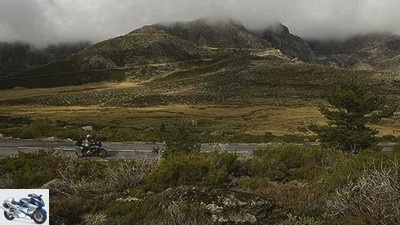
to travel
Out and about in Northern Portugal
Out and about in Northern Portugal
Portugal: true love
Love at first sight ?? that can happen quickly in northern Portugal. Because the charm of the lonely mountain roads, quiet villages or pulsating cities on the Atlantic is very seductive. But what if you risk a second look?
Klaus H. Daams
05/12/2007
It was actually love at first sight, back in the north of Portugal. Trás-os-Montes, land behind the mountains, is the name of the remote region between the Spanish border and the Atlantic. A winding network of seemingly endless streets through lonely Serras and along the terraced vineyards above the Douro river, deserted sandy beaches, villages and bars full of soothing tranquility and, last but not least, the roughly timbered ox-drawn carts, steered by the farmers standing up like Roman chariots Images from other worlds. Archaic Portugal took me by storm 14 years ago.
After long years of raving from afar, I go back to my old love. At the same time as back then, in October, but otherwise a lot has changed. Portugal is no longer seen as a poor house, but as an aspiring member of the European Union. The BMW R 1100 of yore has given way to a KTM 990 Adventure, and companion Susanna made the long journey on the plane. Modern times. Meeting point at Porto.
400,000 inhabitants in the center, 1.6 million in the surrounding area, second largest city in the country after Lisbon, European cultural center in 2001 and ?? Port wine metropolis. Whether you’ve already been there or only knows the city from photos? always the same image should be saved: breathtaking iron bridge and picturesque boats in front of the sea of houses. In realitas, Porto is a tricky tangle of streets, squares and alleys, spread over 140 meters of altitude. In the saddle of our Kati, we stab right into it. If in doubt, always downhill, somehow it will go to the Douro and the famous two-story Dom Luis I Bridge. The boats that used to bring the must from the vineyards 100 kilometers upstream bob gently on the river. Today do the tanker truck; the boats only fill photo albums or hard drives.
We managed to find a free spot of parking space directly on Praça da Ribeira, the central square between the waterfront and the old town. Students in black gowns, which they traditionally wear at the beginning and end of the semester, float like bats over the square. Flanked by wooden giraffes and street vendors selling colorful jewelry. Africa is close, and Portugal’s former colonies Angola and Mozambique send their regards.
A sudden shower drives us under the large umbrellas of the “Casa Peza Arroz” restaurant. We prefer to refrain from the local specialty, tripe (tripas) with white beans, although there is an illustrious piece of history hidden behind this dish: the Portuese once sacrificed all of their cattle in order to provide the crew of Henry the Navigator with meat; for them only the innards remained? and to this day the nickname »tripeiros«, tripe eater. Meanwhile, 63 meters above our heads, a train crosses a bridge reminiscent of the overturned Eiffel Tower. No wonder, since it comes from a student of the French master constructor. An a cappella quartet at the next table is now setting the mood. With “Love you a little bit more” we hurry to find the way back to the hotel.
Buy complete article
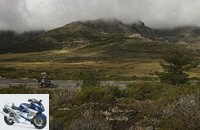
Out and about in Northern Portugal
Portugal: true love
12 pages) as PDF
€ 2.00
Buy now
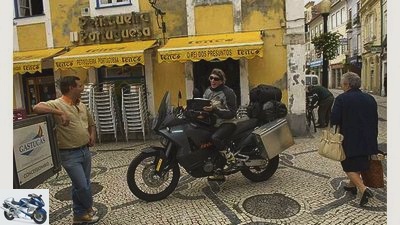
Daams
Entanglements: with a fat travel enduro in Porto’s maze of alleys.
Since morning hour ?? gold, but better still not having a “sandeman” in his mouth, let’s leave it at the countless port wine cellars in the Vila Nova de Gaia district. And then it’s “adeus Porto”. State road 108 on the sprawling north bank of the Douro leads upriver inland and offers ample opportunity to patiently warm up the engine. In the direction of Arouca we change to the smaller N 224, and immediately I recognize it again, “my” Portugal from 1993. The road is a humped band of lived asphalt, twitching like Iggy Pop in adventurous contortions through the botany. Kati greedily follows the course. It smells of lavender and thyme, the national colors shine green and red in the gardens, Erika is sunbathing between the clothesline and grapevines, the trees have smooth snake arms and look as if they had been skinned.
Behind Arouca we take a zigzag course to Alvarenga. Suddenly the street looks like something out of the pattern catalog, with a freshly laid, grippy ceiling and curved radii. Nature, on the other hand, resembles pictures from the »Tagesschau«: extensive destruction by forest fires. An apocalyptic scene.
“It’s a crime, what a pity”, complains Maria Armanda Ribeiro de Sousa of the building sins on the concreted over periphery of Amarante. Above the town we have found comfortable quarters in the “Casa da Pedra”, hidden in the green hills and managed by the retired village school teacher Maria. She means well with her guests, serves biscuits according to a recipe handed down by monks, the papos d ?? anjo, angel necks, and port wine without a flashy label. As a parting present the next morning it even rains two roses, the Kati ?? well equipped even for such rare eventualities? Stowed away wrinkle-free in the glove compartment.
In keeping with the roses, Amarante turns out to be very romantic at its core. An impressive granite bridge spans the sluggish Tâmega, many of the old town houses have shingle roofs, a Renaissance church attracts the rest of the eyes. The city’s patron saint is São Gonçalo, the patron saint of lovers. In his honor there is a half-meter-long phallic-shaped biscuit at the market stall. The bulky fun costs five euros.
At a pace, we jet on the well-developed IP 4 to the northeast towards the Spanish border, then penetrate the mountainous hinterland on the N 314. The route leads via Avidagon and Abreiro through a barren landscape with almost 1000 meter high mountains, piled up like churned seas, in which the travel enduro feels like, logo, a fish in the water. Cut. The local men don’t exactly look like Figo, says Susanna during a stopover; after all, the Portuguese are mostly charming and not so papagally. What else do you notice? Definitely the many cork oaks, the peeled trunks of which taper downwards and are smooth like anodized upside-down forks.
The speedometer and tachometer shine orange against the moon when we arrive at the stage destination Miranda do Douro late in the evening. The secluded nest of 2,000 souls on the Spanish border is in Trás-os-Montes, the region that made my heart pound in the year 93 with its archaic character. And today? Let’s wait until morning.
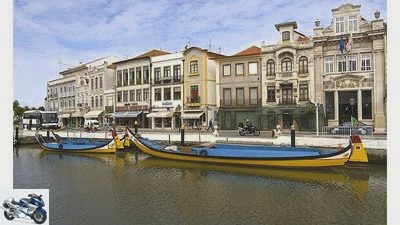
Daams
A touch of Venice on the Grand Canal in Aveiro.
Far from the cathedral of Miranda, located high above the Douro, you can see into the country. And almost forgets to look into the house of God at the curious “Jesus Child with the Top Hat”, a popular votive offering from the 19th century. In search of a similarly original souvenir, we stumble into the shop »Pardo e Surrobeco« ?? the realm of Lili, which sells handcrafted ponchos, scarves and bags made of felt. Before the sewing machine needle and scissors whiz away and the V2 gets its spurs, Susanna stows a donkey bag on the KTM.
We ride south on the N 221. Bilingual place-name signs are an indication of the »mirandês«, an idiom derived from Latin, which is still widespread here. “And what about the ox carts à la Ben Hur?” In Duas Igrejas I want to know, turn off the main road into the village. Pumpkin calves stand in front of the simple houses, and cows graze in a square made of rough stones. The interest of the two strangers does not go unnoticed. A farmer kindly asks us into his stable, where a little calf is suckling on mum’s teat under a vault of thick cobwebs. But there is no team of oxen far and wide, neither here nor anywhere else. Times have really changed.
At Travanca there is a round off-road on dirt roads. Kati dusts and snorts happily. Highnoon. An abandoned tractor dozes in the midday heat, next to it a cat chases after a feather-light hay ball. But the Torre calls us, at 1993 meters the highest mountain on the Portuguese mainland, further south. We proceed quickly on the N 221, which is twisted like a corkscrew, past terraces full of olive trees, covering the hills like green knobs, while the waters of the Douro billow deep below. Suddenly the floods come from above, a real downpour. We flee to a bus shelter, somewhere along the way pulling household gloves made of raspy blue plastic over the leather fingerlings.
As black as the night is now, the lights of Covilhã at the foot of the Torre in the Serra da Estrela sparkle a little later. The St. Moritz of Portugal, so to speak. And in fact, the staff of the Hotel Turismo welcomed us perfectly as if from a Swiss tourism school, even though we splashed into the foyer, frozen and soaking wet. What happens here more often, albeit more in winter: The Serra da Estrela, the Star Mountains, is the only ski area in Portugal, the mountains climb to almost 2000 meters. Now in October, lichens and mosses dominate the rugged slopes, where the vegetation says goodbye at an altitude of 1000 meters. Accordingly, the landscape would also fit well with Scotland or Scandinavia. And best of all: empty streets as far as the eye can see.
From the Serra da Estrela it goes downhill to Aveiro on the Atlantic Ocean, the Venice or Amsterdam of Portugal, as the city is often called in a slight exaggeration. We enjoy the sunset on the offshore beach. Salty air, amazement and silence. A clear view of America. With a heavy and full heart, we return to the lively center of Aveiro. 12,000 students live here, and the nightlife foams from every pore. Between beer from plastic cups and drum bass from the bars on Rua do Tenente Rezende, we get to know Stephanie and Amália. You study, one “language business”, the other “computer technologies” and both of them live life to the fullest.
To warm up, we rush with Kati to the sea near Costa Nova the next morning, to colorful striped houses like out of a Haribo bag and then a round canyon whizzing in the Serra da Arada, in villages with Repsol bars and friendly gentlemen on Mokicks ?? distant relatives of the two-wheeler that was given to the Portuguese Armando Rodrigues de Sá on September 10, 1964 as a millionth guest worker by the West German government when he arrived at Cologne-Deutz station. And that today in the Haus der Geschichte in Bonn is a reminder of the hard-working post-war history between our countries.
We’re back in Porto for the Gran Finale, allow us a visit to a Fado bar ?? after all, that’s part of a trip to Portugal. “Fado means a very deep and sad feeling”, the friendly receptionist explained the concept of this traditional music style to us in the Hotel Turismo in the Serra da Estrela. Despite the alleged melancholy, we spend an entertaining evening in the »O Fado« restaurant and fall into bed more tired than sad.
A few weeks later I get mail from Jesus. No, not a Christmas package. It was a registered letter from Portugal, signed by Jesus Machado Lopes, Chefe de Divisão in Bragança, who caught me with their speed camera on my journey. One and a half pages of Portuguese official Chinese, peppered with vocabulary that even a Portuguese friend, who has lived in the Ruhr area for 35 years, has never heard. Coercive detention? Requests for legal assistance? Oh you beautiful EU! Did Jesus ?? Colleagues already on site 120 euros. Let’s see how it goes on. Sometimes true love can be quite complicated and painful.
Info
The two large rivers Douro and Tejo divide Portugal into a northern, central and southern part. The lonely northern highlands of Trás-os-Montes are an alternative to the popular beaches of the Algarve.
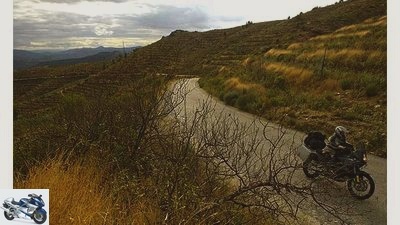
Daams
The reward for the effort: ice-free top routes.
getting there
Viewed from Germany, is Portugal more than a stone’s throw away ?? from Cologne to Porto it is about 2070 kilometers. If you don’t want to cover the long journey entirely by axle, you can choose the motorail train to Narbonne in the south of France. Costs from Dusseldorf for one person with a motorcycle in the low season: from 206 euros. Departure in the afternoon, arrival well rested the next day at 10:08 am. www.db-autozug.de; Service telephone 01805/241224 (14 ct / min). From Narbonne it’s still around 1300 kilometers to Porto via the Pyrenees and Spain.
Travel time
Northern Portugal’s coastal region is blessed with tolerable summer and mild winter temperatures because of the Atlantic climate. In the interior of the country, the difference is more extreme, in the almost 2000 meter high Serra da Estrela even so much snow that there is enough for winter sports. Spring or autumn are best for motorcycling. Not least because it is nice and empty everywhere.
accommodation
You are well accommodated in the following quarters: “Casa da Pedra” near Amarante (about five kilometers north-west towards Lufrei), double room around 65 euros, phone 00351/255422997, www.casadapedra.com.pt; »Estalagem Sta. Catarina «in Miranda do Douro, double room around 90 euros, phone 00351/273431255, www.estalagemsantacatarina.pt; “Hotel Turismo” in Covilhã, double room around 60 euros, phone 00351/275330406, www.imb-hotels.com; Hotel Moliceiro in Aveiro, double room around 95 euros, phone 00351/234377400, www.hotelmoliceiro.com. Two different tips for Porto, both directly on the Douro in the old town: the luxurious Hotel Pestana, double room from around 130 euros, phone 00351/223402300, www.pestana.com; the simple Pension Universal, double room around 50 euros, phone 00351/222006758.
literature
The Allianz travel guide from Baedecker Verlag for 25.95 euros and the travel guide from Michael Muller Verlag for 22.90 euros provide information under the heading “Portugal”; The Allianz tape comes with a good road map on a scale of 1: 350,000, while the competition offers more extensive tips on the topics of accommodation and eating in comparison. Marco Polo also provides two car maps (1: 300,000) plus a travel guide for an inexpensive 7.50 euros in a set under the title »Portugal«. It is recommended to provide an overview? and for driving through Spain ?? from Michelin sheet 734 “Spain ?? Portugal” on a scale of 1: 1 million and for inland the Michelin sheet 733 “Portugal”, 1: 400,000, each 7.50 euros.
Information
ICEP, Portugal Trade and Tourism Office, phone 0180/5004930 (12 ct / min.), Www.visitportugal.com.
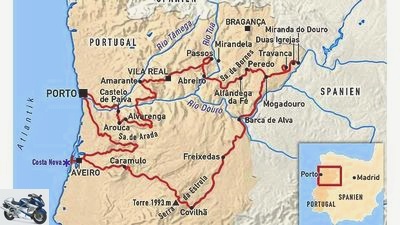
Map: Maucher
Duration of the trip: six days; Distance covered: 1400 kilometers.
Fado music
Fado, derived from the Latin fatum (destiny), is considered to be the typical music of Portugal. The vocals, accompanied by two guitars, are mostly about unhappy love, social grievances and better times. Bittersweet melancholy, which is also often sold as a Portuguese attitude towards life and conveys far more than mere folklore or folk music. Dictator Salazar, head of government from 1933 to 1968 (democratic change only in 1974 due to the legendary Carnation Revolution), hated Fado because of its fatalistic attitude. The origin of Fado is unclear: whether it was inherited from the Moorish rulers, invented as a lament by African slaves and imported via Brazil or created by homesick Portuguese sailors? What is certain is that this music spread in the slums of Lisbon at the beginning of the 19th century. If you want to experience Fado live today, you can do so in special bars, especially in Lisbon, Coimbra (cheerful political style) and Porto. Mariza, born in 1976 in the former Portuguese colony of Mozambique and now the world’s most successful fado singer, artistically short-cropped and bleached, proves that none of this has to be yesterday.
Tickets abroad
The Europe-wide legal assistance with fines is not yet in force, according to which fines over 70 euros are to be enforced in all EU member states. So if you don’t pay the foreign ticket, you will be asked to pay later at home. Currently, fines can only be collected directly on site; notices sent to your home by post are basically ineffective (exception: Austria). However, if you do not respond to this letter, you will have to visit ?? and an identity check ?? expect trouble in the respective country. Www.adac.de and www.bmj.de provide information on the status of legal matters.
Related articles
-
to travel Northern Portugal Northern Portugal Europe’s last exit If you want to travel to Portugal, you need a lot of patience and a durable tire. Once…
-
to travel Portugal Portugal How enchanted The rocky coast of the Algarve, the pulsating metropolis of Lisbon, the harsh hinterland in the south of…
-
to travel South Portugal South Portugal Rock festival In the Algarve, the Atlantic has modeled a magnificent rocky landscape. Between the coast and the…
-
Michael Schroder to travel Three days in Portugal Three days in Portugal In the last minute There was actually a lot of gardening on the agenda that…
-
Motorcycle tour in Northern Thailand
Jo Deleker 36 pictures Deleker 1/36 Traveling by motorcycle in Northern Thailand. Deleker 2/36 Traveling by motorcycle in Northern Thailand. Deleker 3/36…
-
to travel Northern Greece Northern Greece Souvláki, booze & Sunshine?????????? …can be found on Mýkonos. The tranquility of almost forgotten regions,…
-
Daams to travel Northern Germany Northern Germany Down the drain… The economic downturn and global structural change have had a massive impact on…
-
Motorcycle tour in Portugal: relaxed through the north
Markus Jahn 28 pictures Markus Jahn 1/28 Fly to Porto with small luggage – and from there feel like a factory driver. Freeride Spirit founder João Roxo…
-
Deleker 13th pictures Joachim Deleker 1/13 There are many small towns to explore. Joachim Deleker 2/13 A beautiful panorama at sunset. Joachim Deleker…
-
Motorbike Tour – Madeira (Portugal)
Deleker 14th pictures Deleker 1/14 The old north coast road is a spectacle for all the senses, you’ll never forget that. Deleker 2/14 Sunset on the Pico…